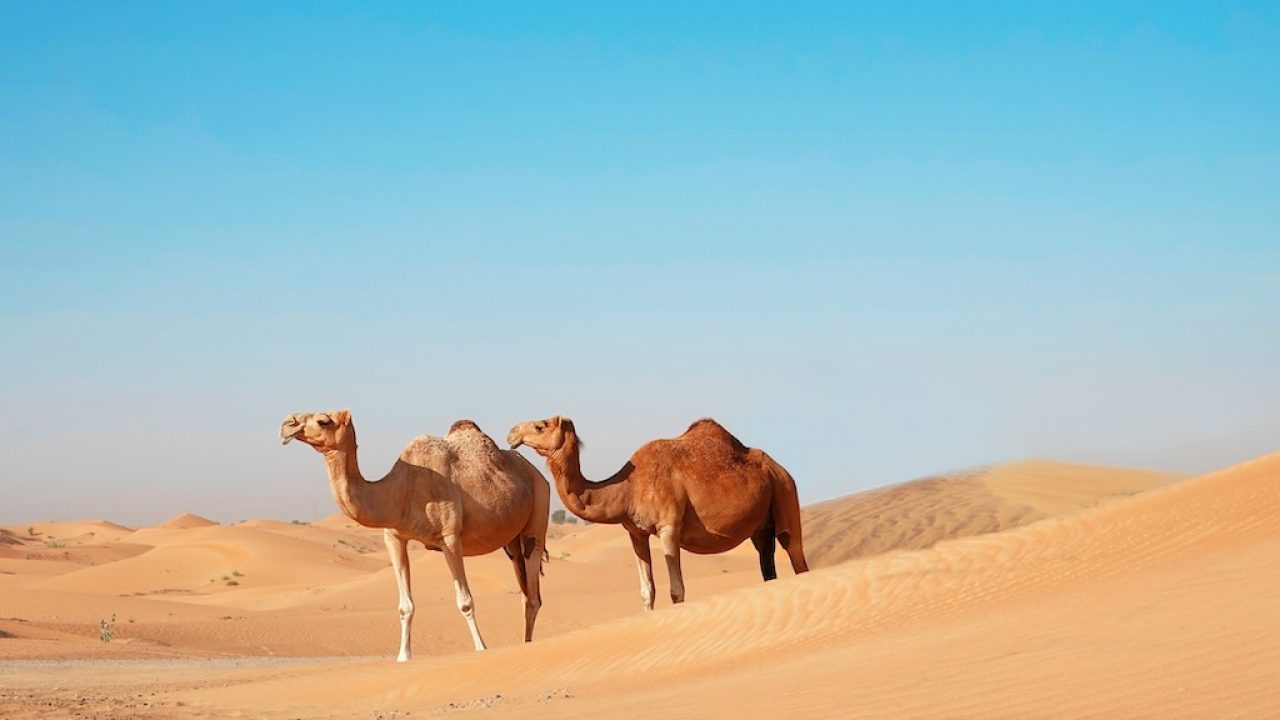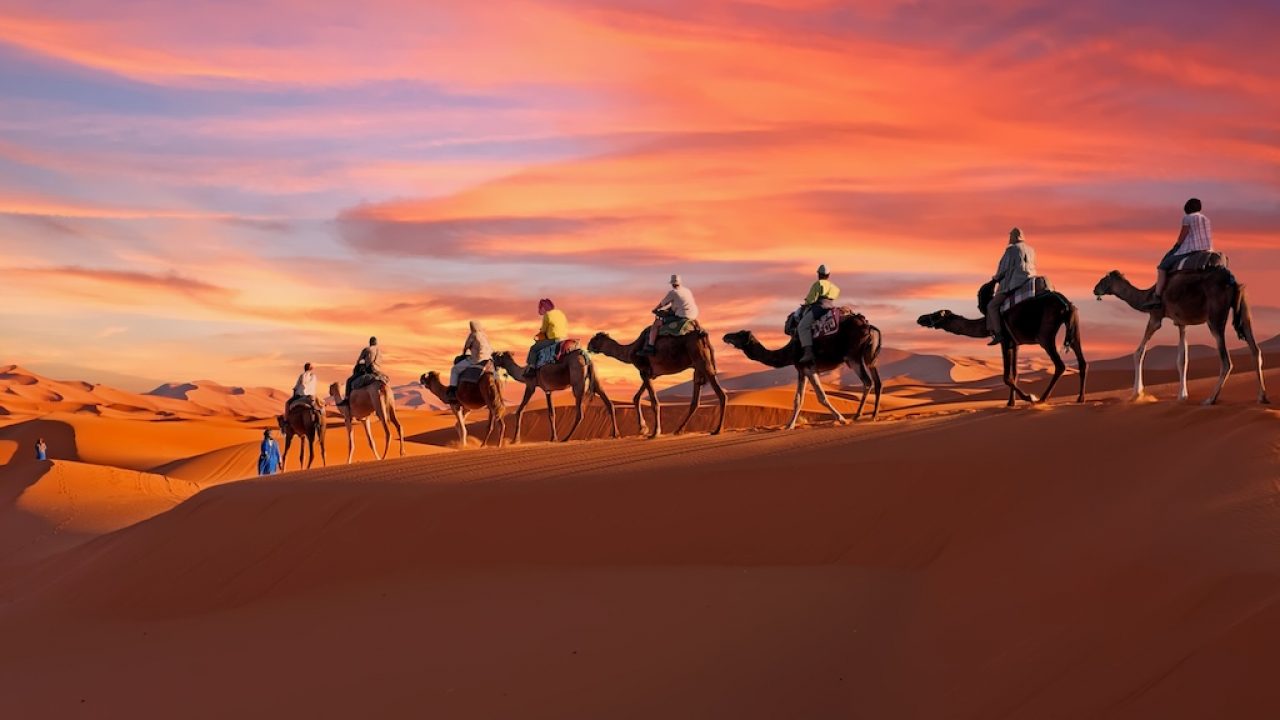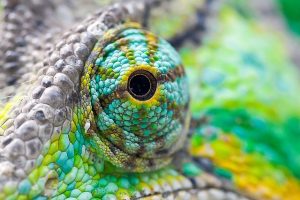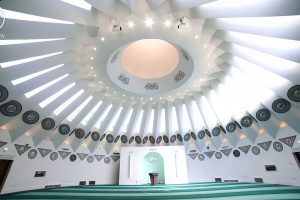
© Shutterstock
Exploring nature’s masterpiece of strength and adaptability
Musa Sattar, London, UK
Deputy Science Editor
In the diverse realm of Earth’s wildlife, one creature stands as a testament to nature’s ingenuity and resilience:
The camel.
With its towering presence and stoic demeanour, the camel embodies strength, adaptability and an unrivalled beauty that captivates the imagination.
These true marvels of the animal kingdom possess a unique set of features that equip them for survival in one of the harshest environments known to man. From the towering dunes of the Sahara, to the blistering heat of the Arabian Desert, camels roam with grace and power, defying the odds with every step.
Camels reach up to 6 feet (1.8 m) at the shoulder and stretch to lengths of 10 feet (3 m). When fully grown, they typically weigh between 1,320 to 2,200 pounds (600 to 1,000 kg), commanding respect with every stride.
One of the most awe-inspiring attributes of camels is their unparalleled strength. With muscles honed by millennia of evolution, they can carry heavy loads across vast distances with ease. Their sturdy legs and broad feet distribute weight evenly, allowing them to traverse treacherous terrain without faltering.
Interestingly, camels boast an impressive carrying capacity, shouldering burdens ranging from 375 to 600 pounds (170 to 270 kg) with ease.
In the annals of history, camels have played a pivotal role in shaping the destinies of nations and facilitating the movement of people across vast distances. Nowhere is this more evident than in the pilgrimage of Hajj, the sacred journey undertaken by millions of Muslims each year to the holy city of Makkah.

© Shutterstock
For centuries, before the advent of modern transportation, camels served as the primary mode of travel for pilgrims embarking on the arduous pilgrimage to Makkah. These majestic creatures, with their unparalleled strength and endurance, enabled thousands of devout Muslims to traverse the unforgiving terrain of the Arabian Peninsula, braving the scorching heat and treacherous sands to fulfil their religious obligations.
But strength is just one facet of the camel’s remarkable nature. Their adaptability is equally astounding, allowing them to thrive in environments where other creatures would perish. With their specialised humps that store fat reserves for sustenance during long journeys, camels can endure weeks without water, navigating desolate landscapes with unparalleled resilience.
As the Scientific Director of the Central Veterinary Research Laboratory in Dubai, Dr Ulrich Wernery, an expert on camel research, stated, ‘Camels are amazing animals, they have fantastic qualities, able to survive without water for two weeks in temperatures of 50-degree centigrade in the shade. They can drink water that is 3% salt.’
Camels’ thick fur protects them from the scorching sun by day and insulates them against the biting cold by night, ensuring their survival in the most extreme climates. Inspired by this ability, scientists have developed a cooling technology that mimics camels’ ability to stay cool in extreme heat. This system combines hydrogel and aerogel: hydrogel evaporates water to cool surfaces, while aerogel, the world’s lightest solid, insulates the hydrogel from ambient heat and slows water evaporation. According to MIT engineer Jeffrey Grossman, camels need both sweat and fur to conserve water. This innovative technology, offering sustained cooling, has potential applications in building insulation and personal cooling devices. While camels naturally replenish moisture through sweat, the gel in this technology needs regular recharging with water, leaving scientists once again unable to replicate the intricate way in which nature has created perfect systems to sustain life.
One of the most notable features is a camel’s long, thick double rows of eyelashes, which serve as a natural barrier against the blowing sands of the desert. These elegant lashes act as a shield, deflecting particles of sand and dust away from the delicate surface of the eye, ensuring clear vision even in the midst of a raging sandstorm.
But the ingenuity of the camel’s eyes does not end there. Camels protect their eyes from the sand with the use of the nictitating membrane, which is also referred to as a translucent third eyelid, protecting the eyes from irritation and injury. This reflexive action, combined with the natural lubrication produced by the eye, helps to keep the delicate cornea moist and free from debris, ensuring optimal vision in the harsh desert environment.
By understanding how the camel’s long eyelashes and rapid blinking protect its eyes from sand and dust, researchers have developed innovative materials that can repel dirt and debris from surfaces, such as camera cleaning systems.1,2
Scientists have long been intrigued by the camel’s ability to thrive in extreme environments, and they have looked to nature for clues on how to design more efficient and sustainable solutions. For example, its remarkable ability to conserve water has led researchers to investigate ways to mimic this process in arid regions where water scarcity is a pressing concern.
From the sands of the desert to the cutting-edge laboratories of the modern world, the camel continues to inspire scientists and innovators alike, driving progress and pushing the boundaries of human knowledge. In the process, we gain a deeper appreciation for the flawless design of nature’s masterpieces and the timeless wisdom of the Supreme Creator.
Contemplating the splendour of these majestic creatures, we cannot help but ponder the age-old question: if there is no Creator, then who is responsible for such magnificence? In the intricate web of life, from the smallest insect to the mightiest mammal, we see evidence of a guiding hand, a divine artist whose brushstrokes adorn every corner of the Earth. And in the regal presence of the camel, we find a reminder of nature’s boundless beauty and the eternal mystery of its creation.
As Dr Francis Collins, an American physician-scientist, said, ‘I have found there is a wonderful harmony in the complementary truths of science and faith…God can be found in the cathedral or in the laboratory. By investigating God’s majestic and awesome creation, science can actually be a means of worship.’
ENDNOTES
1. https://en.bioxegy.com/post/the-dromedary-our-desert-ally
Further Reading:
https://www.sciencefocus.com/news/desert-camels-inspire-a-new-cooling-technology
David Attenborough, Living Planet: A New, Fully Updated Edition of David Attenborough’s Seminal Portrait of Life On Earth.
Ali A., Baby B., Vijayan R. ‘From Desert to Medicine: A Review of Camel Genomics and Therapeutic Products.’ Frontiers in Genetics. 2019 Feb 19;10:17. doi: 10.3389/fgene.2019.00017.
Wu, H., Guang, X., Al-Fageeh M. et al., ‘Camelid genomes reveal evolution and adaptation to desert environments.’ Nature Communications. 5, 5188 (2014). https://doi.org/10.1038/ncomms6188




Add Comment